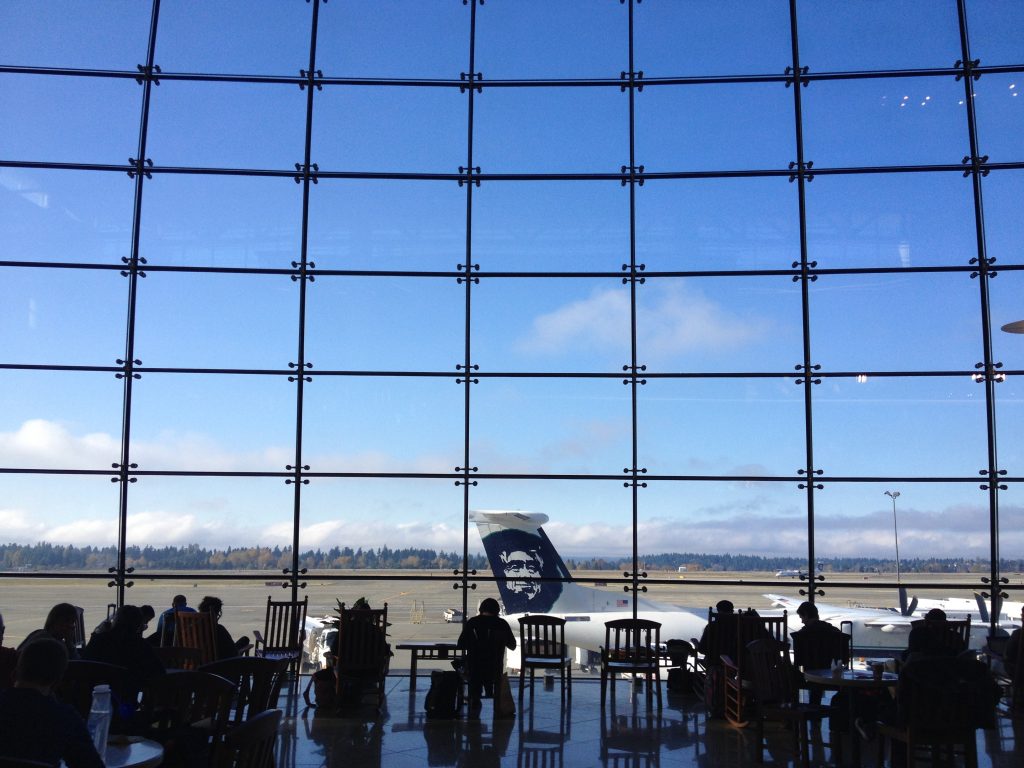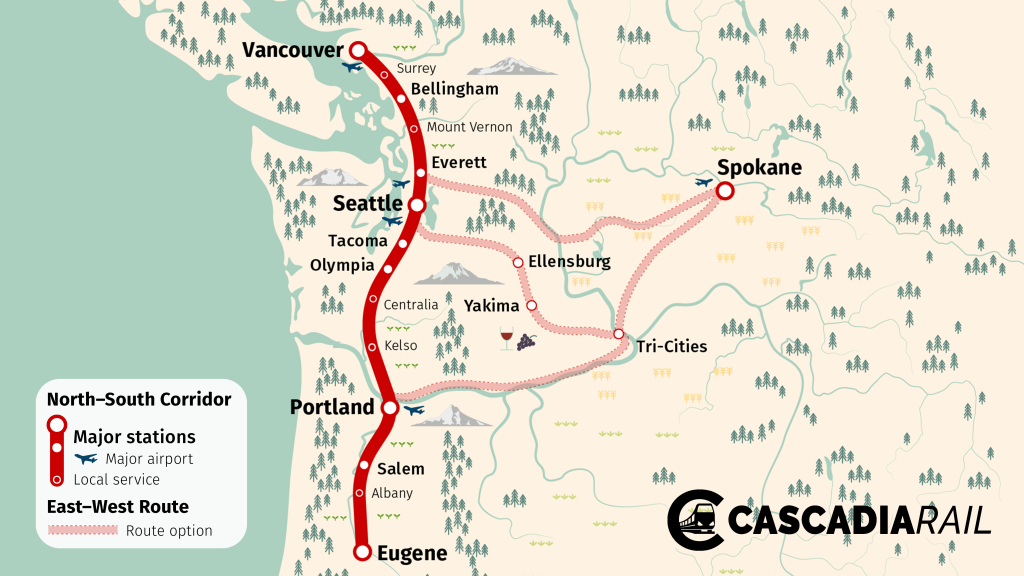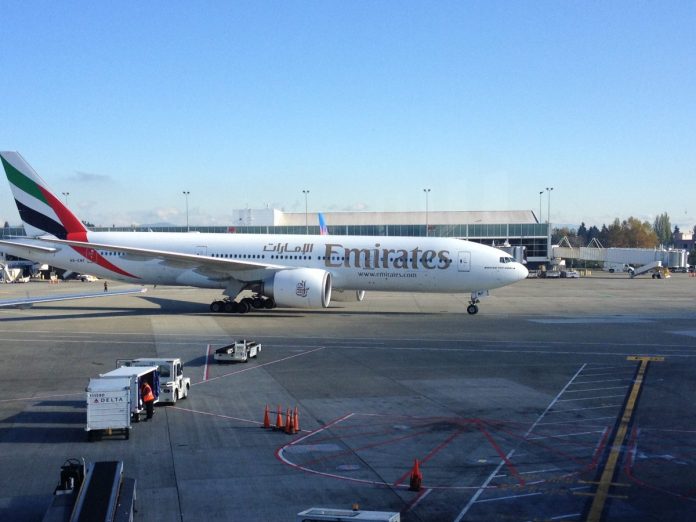On Thursday, the Puget Sound Regional Council (PSRC) released the first part of a multi-year aviation study for the four-county region. The study’s early findings indicate that commercial aviation will see more than a doubling in passenger boardings by 2050. Takeoffs and landings are also forecast to more than double and air cargo demand will rise even faster than passenger growth. This level of growth means that the region will need something on the order of a second major international airport to sustain demand.
Moreover, rapidly climbing air travel demand is something state and regional climate action plans seeking to decarbonize our economy must address. The aviation sector already composed 8% of Washington state emissions in an official 2011 inventory. The state has a goal of reducing greenhouse gas emissions by 80% by 2050 (using the 1990 level as a baseline). Unfortunately, state emissions–and aviation emissions along with them–have been spiking in recent years not dropping. To make matters worse, the route to decarbonizing aviation is pretty speculative at this point.
The study focuses on a variety of dimensions to aviation in order to better understand the role of airports (both commercial and general aviation), airspace use and constraints, landside access to airports and support facilities, and affects on local economic market sectors.
Regional aviation growth more than doubling by 2050
Nationally, Sea-Tac International Airport stacks up high as the ninth busiest airport for commercial enplanements. Commercial passenger flight operations meanwhile sit at thirteenth.
In terms of commercial passenger aviation, the PSRC reports that the 2018 baseline for the region was 24.0 million boardings for departure (enplanements). That was the same year that Sea-Tac Airport saw 49.8 million passengers (enplanements and deplanements) move through its halls. By 2050, commercial enplanements are projected to grow somewhere between 105% and 132%. That translates to 49.3 million to 55.6 million enplanements. Total passenger volumes, when accounting for both enplanements and deplanements, are then likely twice those numbers (98.6 million to 111.2 million passengers).

Commercial passenger flight operations stood at 438,000 in 2018. The increase in operations projected by 2050 is a little less steep than enplanements. Takeoff and landings could rise somewhere between 85% and 109%. That puts the number of flights in the range of 810,000 to 914,000.
Air cargo volumes passing through the region totaled 552,000 metric tons in 2018. By 2050, the PSRC projects that volumes will rise 136% to 1,300,000 metric tons, yet another indicator of just how substantial demand for aviation is looking in a brief 30-year period.
No specific recommendations forthcoming, but capacity investments are needed
While the study will not make recommendations on specific strategies to accommodate regional growth in aviation, the projections strongly indicate that demand for aviation will be acute and that additional investments to accommodate growth is necessary.
The Port of Seattle has already indicated that Sea-Tac Airport will cap out at 66 million annual passengers by 2034. An airport master plan update is underway but planned expansions of the airport are rapidly taking shape. Elements of the master plan update may need to be expedited to keep up with the level of passenger growth being experienced, but once all proposed capacity projects for the airport are realized, there will be little further opportunity to support airport growth there. That means if the 2050 PSRC projections are to be believed, the region will need to decide where to put commercial aviation growth.
Growth could be consolidated at a second major airport, or the region could choose to disperse it at multiple airport locations. Whether one or more sites are chosen, the region could decide on how the additional airport or airports operate, such as an emphasis on regional air travel, international travel, or cargo operations.

Obvious existing airports for this include King County International Airport, Paine Field Airport, and Joint Base Lewis-McChord, but other existing or new airports could be selected instead. A current statewide study is evaluating a second major airport for the state to be fully operational by 2040, but has excluded any site in King County from consideration.
But there are also non-airport options that may be worth exploring to supplant demand between certain destinations and regions. Investments in other modes, such as high-speed passenger rail and freight rail, could shift a substantial number of passengers and cargo to electrified ground transportation, shrinking the carbon footprint of those trips.
Region will grapple with how to mitigate aviation growth
With the increase in passenger volumes, flight operations, and cargo demand, the region, state, and airports will have to determine how to accommodate growth. More flights mean more pollution, noise, and constrained airspace. More passengers and cargo mean more demands for transportation and physical airport space. All of this also has direct impacts on nearby land use compatibility and the local economy.

Discussions surrounding how to mitigate increased air travel demands will follow in the years ahead and some are already happening with airport-specific master plan updates. Questions that will undoubtedly be asked regionally, include:
- Where should a second major international airport or several major airports be located in the Puget Sound region?
- What should future flight paths and patterns look like?
- How can noise be reduced or compensatory measures put into place?
- What kind of environmental mitigation measures should be implemented for emissions?
- How can can emissions be reduced or minimized?
- How viable is electrification of large commercial planes and how soon?
- Should an ultimate cap on flights or slots system be implemented?
- How can other transportation modes be used to complement or supplant air travel and air cargo?
- How do airports in a densely growing region attain better compatibility to other land uses?
These questions are critical and will require substantial engagement between airport operators, industry, communities, and state actors to decide what the future of aviation in the Puget Sound will be.
Stephen is a professional urban planner in Puget Sound with a passion for sustainable, livable, and diverse cities. He is especially interested in how policies, regulations, and programs can promote positive outcomes for communities. With stints in great cities like Bellingham and Cork, Stephen currently lives in Seattle. He primarily covers land use and transportation issues and has been with The Urbanist since 2014.


